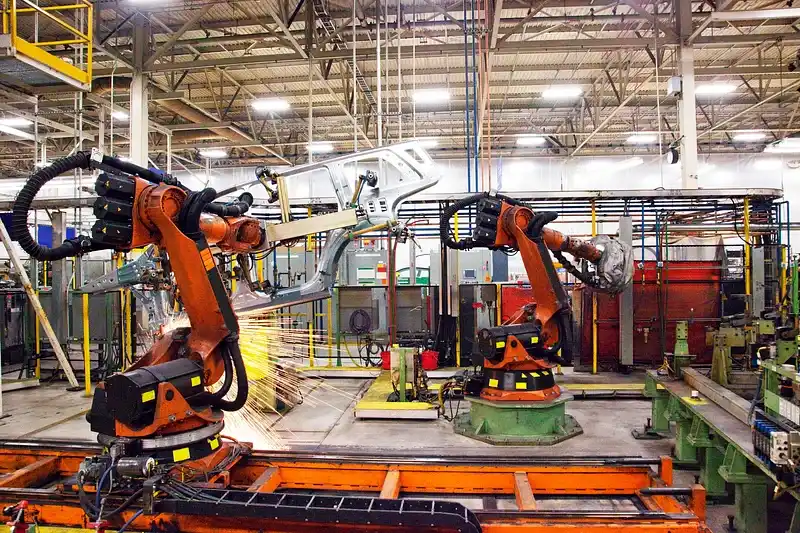Introduction
Embark on a journey into the realm of precision and innovation as we unravel the profound impact of Machine Vision in Quality Control. In this comprehensive guide, we’ll delve into various facets of this technological marvel, demystifying complex concepts for a broader audience.
Understanding Machine Vision
The Eyes of Precision
Machine vision endows machines with keen eyesight, empowering them to see, interpret, and make decisions based on visual input. It’s akin to giving machines the ability to discern the subtlest details, like distinguishing a ripe apple from an unripe one.
Visionary Process Decoded
Delve into the intricacies of how machine vision works, from the initial stages of image acquisition to the sophisticated decision-making algorithms. Understanding this visionary process unveils the magic behind machines’ ability to comprehend and navigate the visual world.
Evolution of Quality Control
Quality control has undergone a metamorphosis, transitioning from manual inspections to an art form with the integration of machine vision. Explore the evolution that has turned a once tedious task into a seamless and efficient process.
Applications Across Industries
Versatility Beyond Limits
Machine vision isn’t confined to a specific industry; its versatility spans various sectors. Uncover its diverse applications, from revolutionizing manufacturing processes to enhancing accuracy in healthcare diagnostics.
Elevating Quality Standards
Explore how machine vision goes beyond the surface, contributing to heightened quality standards across industries. Its impact extends far beyond defect elimination, fundamentally transforming the landscape of quality control.
Benefits Beyond Measure
Discover the hidden advantages of machine vision, ranging from heightened accuracy to increased productivity. The benefits extend far beyond conventional quality control, offering unparalleled precision in every aspect.
Challenges and Solutions
Navigating the Hurdles
Every superhero faces challenges. Delve into the hurdles that machine vision encounters in its quest for perfection. Explore the resilience of industries as they navigate and overcome these challenges to harness the full potential of machine vision.
Future Trends and Innovations
Peek into the future of machine vision and quality control, unraveling upcoming trends and innovations that will reshape the technological landscape. Stay ahead of the curve as industries embrace cutting-edge advancements.
Real-World Triumphs
Explore real-world success stories where machine vision emerges victorious, setting new benchmarks for quality control. These triumphs showcase the tangible impact of machine vision in diverse industries.
Integration and Impact
Seamless Integration Strategies
Discover how industries seamlessly integrate machine vision into existing processes. Explore strategies and considerations, ensuring a smooth and effective incorporation that maximizes the impact on quality control.
Balancing Precision with Humanity
Explore the delicate balance between machine precision and the human touch in quality control. Understand how humans complement machine vision, contributing emotional intelligence and nuanced decision-making.
Return on Investment
Analyze the costs, benefits, and overall return on investment when adopting machine vision. Uncover the significance of investing in precision and technology to ensure sustainable and impactful quality control.
Human-Machine Collaboration
Coexistence of Machine Vision and Human Inspection
Explore the dynamic coexistence of machine vision and human inspection. Understand the strengths each brings to the quality control arena, fostering a collaborative approach for superior results.
Integrating Human Judgment
Delve into the importance of human judgment in quality control processes. Discover how human inspectors provide contextual understanding and decision-making abilities crucial for complex situations.
Synergy for Enhanced Quality
Understand how the collaboration between machine vision and human expertise creates a synergy that surpasses individual capabilities, resulting in an overall enhancement of quality control processes.
Machine Vision vs Human Inspection
In the ever-evolving landscape of quality control, the interplay between machine vision and human inspection sparks a compelling debate. Both bring unique strengths to the table, forming a symbiotic relationship that aims for precision and efficiency. Let’s delve into the intricacies of Machine Vision vs Human Inspection, exploring their roles, strengths, and the delicate balance required for superior quality control.
The Eyes of Technology: Machine Vision
Unmatched Precision
Machine vision operates with a level of precision that surpasses human capabilities. It can analyze vast amounts of data in milliseconds, detecting even the minutest defects in products with unparalleled accuracy.
Consistency and Speed
Machines don’t tire, ensuring consistent performance 24/7. The speed at which machine vision processes information enables swift and continuous quality assessments, a feat challenging for human inspectors.
Data-Driven Decision Making
Machine vision relies on data and algorithms, eliminating subjective biases. It makes decisions based on objective criteria, contributing to standardized and reliable quality control processes.
The Human Touch: Human Inspection
Contextual Understanding
Humans bring a level of contextual understanding that machines may struggle to grasp. The ability to interpret nuances and understand the broader context is a unique strength that human inspectors offer.
Emotional Intelligence
Quality control often involves subjective aspects that require emotional intelligence. Human inspectors can detect subtle variations and understand the emotional impact of defects, contributing to a holistic quality assessment.
Adaptability to Complex Situations
In scenarios where unexpected issues arise or non-routine situations occur, human inspectors excel. Their adaptability and problem-solving skills shine in situations that may challenge machine vision algorithms.
Striking the Balance
Collaborative Approach
The optimal approach to quality control lies in a collaborative effort between machine vision and human inspection. Combining the precision of machines with the contextual understanding of humans creates a powerful synergy.
Human Supervision
While machines handle repetitive and data-intensive tasks, human supervision remains crucial. Humans provide oversight, ensuring that the quality control process aligns with broader organizational goals and ethical considerations.
Continuous Improvement
The collaboration between machine vision and human inspection allows for continuous improvement. Human insights can be used to refine machine learning algorithms, creating a dynamic and evolving quality control system.
Benefits of Machine Vision in Various Industries
Machine vision, with its capability to impart visual intelligence to machines, has become a transformative force across diverse industries. The benefits it brings to the table are substantial, influencing not only manufacturing but also healthcare, logistics, and more. Let’s explore the remarkable advantages of machine vision.
Enhanced Precision and Accuracy
Unmatched Quality Control
Machine vision systems excel in quality control, identifying defects or deviations from standards with unparalleled precision. This results in products meeting the highest quality standards consistently.
Minimized Error Rates
By automating visual inspections, machine vision significantly reduces the risk of human errors. The accuracy of machine vision systems ensures that products adhere to specifications, minimizing defects and errors in the manufacturing process.
Increased Production Yield
The ability of machine vision to swiftly and accurately analyze large volumes of products enhances production yield. Identifying and rectifying issues promptly leads to more efficient manufacturing processes.
Improved Efficiency and Speed
Swift Inspection Processes
Machine vision operates at high speeds, capable of inspecting and analyzing products in real-time. This acceleration in inspection processes directly translates to increased efficiency in production lines.
Rapid Decision-Making
With the capability to process vast amounts of data quickly, machine vision facilitates rapid decision-making. This is particularly valuable in scenarios where prompt responses to defects or anomalies are critical.
Streamlined Manufacturing Workflows
Integration of machine vision systems streamlines manufacturing workflows by automating repetitive tasks. This not only reduces manual workload but also ensures a more seamless and efficient production process.
Versatility Across Industries
Manufacturing Excellence
In manufacturing, machine vision is a cornerstone for ensuring product quality and consistency. From automotive to electronics, it plays a pivotal role in maintaining high standards.
Healthcare Advancements
In healthcare, machine vision aids in diagnostics, precision surgeries, and medical imaging. It enhances the accuracy of medical procedures, contributing to improved patient outcomes.
Logistics and Beyond
Machine vision finds applications in logistics, including barcode reading, package sorting, and warehouse automation. Its versatility extends to diverse industries, offering solutions tailored to specific needs.
Cost-Efficiency and Return on Investment (ROI)
Reduced Production Costs
By minimizing errors, preventing defects, and streamlining processes, machine vision contributes to reduced production costs. The initial investment in implementing machine vision systems often proves to be cost-effective in the long run.
Enhanced Productivity
The increased speed and efficiency brought by machine vision result in enhanced overall productivity. Optimizing manufacturing workflows and reducing downtime contribute to a higher return on investment.
Scalability and Adaptability
Machine vision solutions can be scaled to accommodate changes in production volume or adapt to new products. This scalability ensures that the technology remains cost-effective as businesses evolve.
Safety and Compliance
Workplace Safety
In industrial settings, machine vision contributes to workplace safety by identifying potential hazards and ensuring compliance with safety protocols. This fosters a secure working environment for employees.
Regulatory Compliance
Machine vision systems assist in meeting regulatory standards by ensuring that products adhere to specifications and quality standards. This is particularly crucial in industries with stringent compliance requirements.
Minimized Product Recalls
The early detection of defects through machine vision minimizes the risk of faulty products reaching consumers, reducing the likelihood of costly product recalls and associated reputational damage.
Future Perspectives
Advancements in Machine Learning
As machine learning continues to advance, machine vision systems will become more adept at understanding complex scenarios. This progress will further enhance the collaboration between machines and human inspectors.
Ethical Considerations
As technology evolves, addressing ethical considerations becomes crucial. Striking the right balance ensures that quality control processes remain ethical, fair, and aligned with societal values.
Training and Education
Investing in the training and education of human inspectors and machine operators becomes pivotal. Ensuring that both parties understand the capabilities and limitations of each other fosters a more effective collaboration.
Conclusion
In this comprehensive guide, we’ve unveiled the symbiotic relationship between machines and quality control. From the evolution of inspections to real-world triumphs, future trends, integration strategies, and human-machine collaboration, machine vision is not just a process; it’s a revolutionary force shaping the future of quality control.
In conclusion, machine vision inspection is a game-changer in improving quality control in manufacturing. The combination of advanced technology, real-world success stories, and the potential for human-machine collaboration makes it a vital tool for ensuring product quality and competitiveness. For further inquiries or a demo, you can Contact Trident Information Systems. Stay ahead of the innovation curve! Follow our LinkedIn page for the latest insights and updates on how Vision Intelligence System are revolutionizing The industry.
FAQs
Q1: How does machine vision enhance quality control processes? Machine vision enhances quality control by providing meticulous and rapid analysis, identifying defects with unmatched precision.
Q2: Can machine vision be implemented in small-scale industries? Yes, machine vision systems can be scaled for small-scale industries, offering cost-effective solutions for improved quality control.
Q3: Are there privacy concerns with machine vision in public spaces? Privacy concerns arise, but advancements include features like anonymization, ensuring a balance between surveillance and privacy.
Q4: Can machine vision adapt to changes in product design or specifications? Absolutely! Machine vision systems can be trained to accommodate changes in design or specifications, ensuring flexibility in quality control.
Q5: How do human inspectors collaborate with machine vision systems? Human inspectors complement machine vision with contextual understanding and emotional intelligence, handling complex situations in quality control processes.



